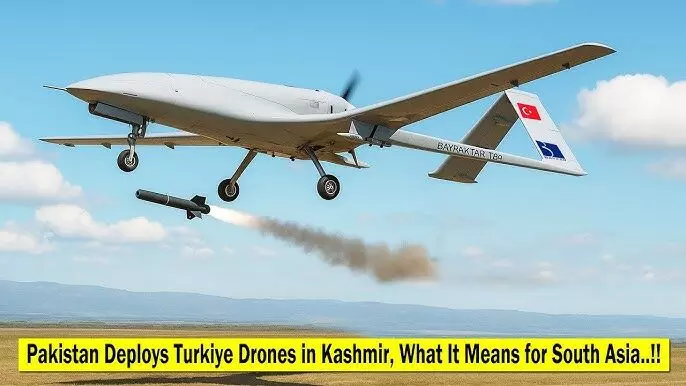Game of Drones: How UAVs Redefined the India-Pakistan Conflict
Explore how drones reshaped the recent India-Pakistan conflict, highlighting the rise of unmanned warfare, India’s technological edge, indigenous innovations, and strategic military implications.
Game of Drones: How UAVs Redefined the India-Pakistan Conflict

In an age where precision and technology increasingly shape the battlefield, drones have emerged as the defining force in modern warfare. The latest confrontation between India and Pakistan signaled a decisive break from traditional military playbooks — with unmanned aerial vehicles (UAVs) leading the charge.
During the most recent border hostilities, drones weren’t just supporting assets — they were central to the conflict. For the first time in South Asia’s long history of military standoffs, UAVs became the primary instruments of surveillance, strikes, and strategic deterrence.
India’s Drone Arsenal: Precision Meets Power
India deployed an array of advanced UAV systems, notably the Israeli-origin Harop loitering munitions and SkyStriker drones, developed through a joint venture between Elbit Systems and Adani-owned Alpha Design Technologies. These systems were instrumental in neutralizing terrorist infrastructure deep within Pakistan and Pakistan-occupied Kashmir (PoK), including key targets in Bahawalpur and Muridke.
The Indian military used satellite imagery to present before-and-after visuals of these precision strikes, showcasing the damage inflicted on Pakistani terror hubs, air defence installations, and airfields. Over 100 militants were reportedly eliminated in these targeted operations — a clear demonstration of the efficacy of loitering munitions, often termed “suicide” or “kamikaze” drones.
Pakistan’s Retaliation: Drones from Turkey and China
In response, Pakistan launched a large-scale counterattack using Turkish-made SONGAR drones and Chinese-origin Byker YIHA III kamikaze UAVs. Over three consecutive nights, waves of drones targeted Indian military bases and civilian areas in Jammu, Udhampur, Pathankot, Bathinda, and border regions in Punjab and Rajasthan.
India’s air defence network, however, quickly adapted. Leveraging its multi-layered systems — including Akash surface-to-air missiles, L70 anti-aircraft guns, and the Russian-built S-400 Triumf — Indian forces neutralized the aerial threats with remarkable efficiency. No casualties were reported, though debris from destroyed UAVs was recovered across multiple states.
India's Superiority in Drone Warfare
The conflict underscored a growing technological edge for India. According to the Stockholm International Peace Research Institute (SIPRI), India was the world’s largest arms importer from 2019 to 2023 and has historically led in UAV imports — especially from Israel. Assets like Heron I, Searcher Mk II, and Harop drones have become staples of India’s aerial reconnaissance and strike capabilities.
More recently, India approved a $4 billion acquisition of 31 MQ-9B Predator drones from the United States — a significant step forward in long-endurance strike capability. These drones can fly for up to 40 hours and operate at altitudes of 40,000 feet, giving India unmatched strategic reach.
DRDO's Push for Indigenous Drones
India's reliance on imported UAVs is gradually giving way to a robust domestic drone development program. The Defence Research and Development Organisation (DRDO), under the “Make in India” and “Atmanirbhar Bharat” initiatives, has ramped up its efforts to build indigenous drone systems for the armed forces.
Key indigenous platforms include:
Rustom Series (TAPAS-BH-201): Medium-altitude long-endurance UAVs designed for intelligence, surveillance, and reconnaissance (ISR).
Nishant: A battlefield surveillance drone with day/night capability.
Lakshya: A subsonic aerial target for training and weapon testing.
Micro/Mini UAVs: Platforms like Black Kite, Golden Hawk, and Pushpak for short-range ISR missions.
Loitering Munitions: DRDO is developing kamikaze drones for precision strike roles.
Counter-Drone Systems: The D4 system, equipped with radar, RF sensors, jamming tools, and laser weapons, has proven effective in deterring rogue UAV threats.
Pakistan’s Drone Capabilities: Dependent on Allies
Pakistan’s drone capabilities, while expanding, remain heavily reliant on imports — primarily from China and Turkey. Between 2020 and 2024, China accounted for 81% of Pakistan’s arms imports. The Chinese-supplied CH-4A drones and possibly Bayraktar TB2 drones from Turkey form the backbone of Islamabad’s UAV fleet.
Despite their offensive push using these systems, Pakistan’s drone fleet struggled against India’s superior air defence and counter-drone measures.
India's Defensive Advantage
India’s deployment of the DRDO D4 counter-drone system proved a game-changer. It successfully detected, tracked, and neutralized a significant portion of Pakistan’s drone fleet using both soft-kill (jamming, spoofing) and hard-kill (laser) technologies. The integration of this system into India’s existing air defence layers — Akash missiles, L70 guns, and S-400 systems — ensured a robust shield against incoming threats.
India’s response was not just defensive. It retaliated with equal — if not greater — firepower, deploying loitering munitions and surveillance UAVs to strike targets and gather critical battlefield intelligence.
Why Drones Took Center Stage
The dominance of drones in this conflict wasn’t accidental — it reflected a strategic shift rooted in geography, geopolitics, and risk management. As nuclear-armed neighbors, both India and Pakistan are acutely aware of the catastrophic potential of full-scale war. Drones offer a low-risk, high-precision alternative to manned incursions — enabling nations to deliver powerful messages without crossing red lines.
Beyond their operational effectiveness, drones also exert psychological pressure. Their constant presence deters movement, monitors enemy activity, and enables real-time decisions. From border surveillance to surgical strikes, UAVs offered India a decisive advantage in this limited but high-stakes confrontation.
A New Era of Warfare
The recent India-Pakistan drone skirmish marks a pivotal moment in South Asian military history. Gone are the days when conflicts were dominated by tanks, artillery, or fighter jets. The future lies in remote warfare — silent, strategic, and driven by machines.
It’s not just boots on the ground anymore. It’s bots in the sky.

